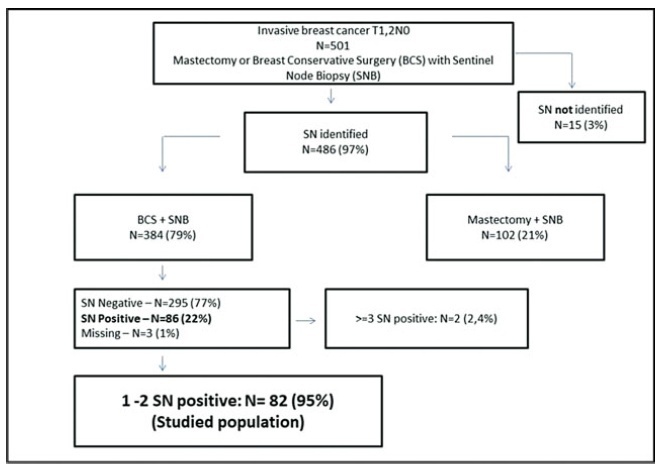-
Original Article
Potential Impact of the Z0011 Trial on the Omission of Axillary Dissection: A Retrospective Cohort Study
Revista Brasileira de Ginecologia e Obstetrícia. 2021;43(4):297-303
03-30-2021
Summary
Original ArticlePotential Impact of the Z0011 Trial on the Omission of Axillary Dissection: A Retrospective Cohort Study
Revista Brasileira de Ginecologia e Obstetrícia. 2021;43(4):297-303
03-30-2021Views154See moreAbstract
Objective
To evaluate the number of patients with early-stage breast cancer who could benefit from the omission of axillary surgery following the application of the Alliance for Clinical Trials in Oncology (ACOSOG) Z0011 trial criteria.
Methods
A retrospective cohort study conducted in the Hospital da Mulher da Universidade Estadual de Campinas. The study population included 384 women diagnosed with early-stage invasive breast cancer, clinically negative axilla, treated with breast-conserving surgery and sentinel lymph node biopsy, radiation therapy, chemotherapy and/or endocrine therapy, from January 2005 to December 2010. The ACOSOG Z0011 trial criteria were applied to this population and a statistical analysis was performed to make a comparison between populations.
Results
A total of 384 patients underwent breast-conserving surgery and sentinel lymph node biopsy. Of the total number of patients, 86 women underwent axillary lymph node dissection for metastatic sentinel lymph nodes (SNLs). One patient underwent axillary node dissection due to a suspicious SLN intraoperatively, thus, she was excluded fromthe study. Among these patients, 82/86 (95.3%) had one to two involved sentinel lymph nodes andmet the criteria for the ACOSOG Z0011 trial with the omission of axillary lymph node dissection. Among the 82 eligible women, there were only 13 cases (15.9%) of lymphovascular invasion and 62 cases (75.6%) of tumors measuring up to 2 cm in diameter (T1).
Conclusion
The ACOSOG Z0011 trial criteria can be applied to a select group of SLNpositive patients, reducing the costs and morbidities of breast cancer surgery.

-
Artigos Originais
Tactile sensibility in arm of women subjected to the axillary lymph node dissection for breast cancer
Revista Brasileira de Ginecologia e Obstetrícia. 2009;31(7):361-366
10-09-2009
Summary
Artigos OriginaisTactile sensibility in arm of women subjected to the axillary lymph node dissection for breast cancer
Revista Brasileira de Ginecologia e Obstetrícia. 2009;31(7):361-366
10-09-2009DOI 10.1590/S0100-72032009000700007
Views87See morePURPOSE: to identify sensitivity alteration in the intercostal brachial nerve pathway using an extensiometer, and to observe the measurement reproducibility of the apparatus. METHODS: the Semmes-Weinstein extensiometer was used to evaluate the sensitivity along the intercostal brachial nerve pathway. Ninety-four women have participated in the study, divided into two groups: a CA Group composed of 47 women submitted to breast cancer axillary lymphadenectomy, and a comparative group composed of 47 women without breast cancer, who had not been submitted to any kind of axillary surgery. Each participant underwent anamnesis and two consecutive applications of the extensiometer. The Control Group responses to the extensiometer test were used as normality reference values. RESULTS: based on Control Group responses, the prevalence of sensitivity changes was 85.1% in the CA Group. Reproducibility of the extensiometer application was confirmed in the CA Group through the Kappa's test (p=0.8). CONCLUSIONS: in this studied sample, sensitivity alterations had high prevalence; evaluations made with the extensiometer were reproducible, and thus we consider the equipment reliable to evaluate sensitivity along the intercostal brachial nerve pathway.


